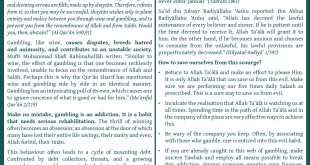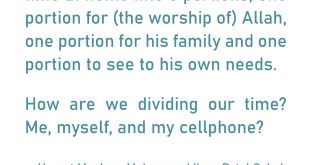
Hazrat Moulana Gangohi (rahimahullah) and His Adherence to the Sunnah
Hazrat Moulana Rasheed Ahmed Gangohi (rahimahullah) was a great Aalim, Muhaddith, Faqeeh and saint of his era. He was a descendant of Hazrat Abu Ayyoob Ansaari (radhiyallahu ‘anhu) – the Sahaabi in whose home Rasulullah (sallallahu ‘alaihi wasallam) stayed at the time when he made hijrah to Madinah Munawwarah.
Hazrat Moulana Gangohi (rahimahullah) was blessed with many outstanding qualities, among which was his deep love and strong commitment to the blessed sunnah. Below are three incidents which reflect his deep concern and effort to uphold the sunnah in his life at all times:
Incident One
In the year 1301 AH, Daar-ul-Uloom Deoband held its fourth graduation jalsah. Moulana Gangohi (rahimahullah) attended this jalsah and was also requested to tie the turbans on the heads of the graduating Ulama.
On this occasion, Moulana Gangohi (rahimahullah) became slightly delayed in leaving for salaah. Hence, when he arrived at the musjid, he found that though he had not missed the rakaat, he had missed the Takbeer-e-Oola (the first takbeer with the imaam).
After making salaam and completing the salaah, when the people looked at Moulana Gangohi (rahimahullah), they noticed that he was extremely grieved and sorrowful. Moulana Gangohi (rahimahullah) lamented and said, “How sad! Today, after twenty years, I have missed the Takbeer-e-Oola!”
From this incident we understand the great importance that Hazrat Moulana Gangohi (rahimahullah) showed to performing salaah in the musjid with jamaat, as well as performing the salaah with the Takbeer-e-Oola.
Incident Two
On one occasion, the shoes of Moulana Gangohi (rahimahullah) were outside the door of the musjid. However, since the sunnah when leaving the musjid is to exit with the left foot, and the sunnah when wearing shoes is to commence with the right foot, the people wondered how Moulana Gangohi (rahimahullah) would be able to practice on both these sunnats.
If Moulana (rahimahullah) exited with the left foot, then he would be stepping into his left shoe first. Conversely, if he put his right foot into the shoe first, then he would be exiting with his right foot. Thus, the people decided to wait and observe Moulana Gangohi (rahimahullah) when he exited from the musjid in order to see the manner in which he would practice on both sunnats.
When Moulana Gangohi (rahimahullah) came out from the musjid, the people saw that he exited with his left foot and placed both his feet on his shoes, without wearing them. He then wore his right shoe, followed by his left shoe. In this manner, Moulana Gangohi (rahimahullah) ensured that he practiced on both sunnats of Rasulullah (sallallahu ‘alaihi wasallam) correctly.
Third Incident
Once, Moulana Gangohi (rahimahullah) was teaching the students of Hadith in the open courtyard of the musjid when it began to rain. The students immediately picked up their kitaabs and desks and rushed into the musjid in order to avoid getting wet. As the students rushed into the musjid, they were surprised to see their ustaad, Moulana Gangohi (rahimahullah), carrying their shoes in his shawl and entering the musjid behind them. They realized that since they were concerned about protecting the books of Hadith from becoming wet, they had forgotten to pick up their shoes. Hence, their ustaad, Moulana Gangohi (rahimahullah) had made their khidmah by picking up their shoes and saving them from becoming wet.
When the students saw this, they felt ashamed and some of them even began to weep, asking Moulana (rahimahullah) why he had carried their shoes for them, whereas he was their Ustaad. Moulana Gangohi (rahimahullah) replied, “The Hadith mentions that the fish in the ocean make du‘aa for the students of deen, and the angels spread their wings beneath the feet of the students of deen. When the students of deen enjoy such honor in the sight of Allah Ta‘ala, then I wished to acquire the good fortune of serving them and bringing them comfort.”
The Sahaabah (radhiyallahu ‘anhum) were an embodiment of the Mubaarak Sunnah, but lived in an era that was distant from our time. When we observe the lives of our Akaabir, we find that they were living examples of the Mubaarak Sunnah and showed us how to practice upon the Sunnah in contemporary times.
May Allah Ta‘ala grant us the tawfeeq to emulate every sunnah of Rasulullah (sallallahu ‘alaihi wasallam) in our lives.
Source:Ihyaauddeen
 Wifāq ul Ulāma (SA) ASSOCIATION OF SOUTH AFRICAN 'ULAMA
Wifāq ul Ulāma (SA) ASSOCIATION OF SOUTH AFRICAN 'ULAMA


